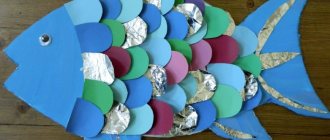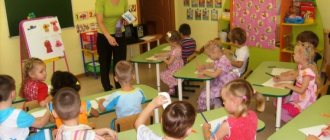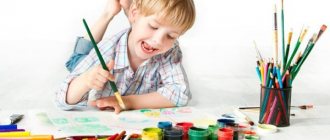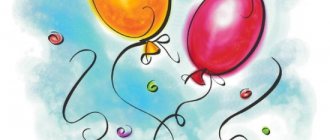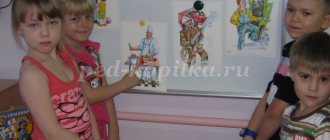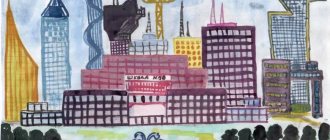The importance of non-traditional drawing techniques for children's development in the garden
Unconventional drawing is interesting because children’s images always turn out different. As a rule, these are simple and accessible techniques, however, they play a very important role in the mental development of a preschooler. Their use presupposes an atmosphere of ease, allowing the child to take the initiative and express feelings and emotions in the drawing. The main thing in such activities is not the final product, but the formation of a self-confident personality.
The use of non-traditional techniques develops the research abilities of 4-5 year old children. After all, they provide the opportunity to experiment (for example, mix gouache with soap foam, apply paint to natural materials).
Non-traditional drawing improves the fine motor skills of middle group preschoolers, which in turn contributes to the development of correct speech.
Mental processes such as thinking, attention, visual memory, and imagination develop.
Tactile sensitivity increases - the fingertips are in direct contact with the paint, feeling its thickness and viscosity.
Working with unusual materials makes children wonder, improves their social and communication skills: children ask more questions to the teacher, to each other, their vocabulary is enriched and activated.
Notes on drawing a squirrel using the “poke with a hard brush” technique in the preparatory group
IRINA CHECHETKINA
Notes on drawing a squirrel using the “poke with a hard brush” technique in the preparatory group
Program content: Introduce children to the work of the illustrator E. I. Charushin. To develop children's ability to draw animals using the poking technique with a hard semi-dry brush , to consolidate their knowledge about the appearance and habits of squirrels . Continue teaching children to paint with gouache , mixing it to get the desired color. Systematize children's ideas about the adaptability of animals to winter conditions. Learn to analyze your work and the drawings of your comrades. To develop aesthetic perception, color perception, the ability to convey the characteristics of an animal in work, using unconventional drawing techniques , as well as curiosity, memory and coherent speech of children; expand the vocabulary with possessive adjectives: squirrel, fox, bear. To cultivate observation, a humane attitude towards animals. Demonstration material: presentation with illustrations for books and a portrait of E. I. Charushin, subject pictures (squirrel, for the game - mushrooms, nuts, acorns, orange, banana, apple, books with illustrations by various artists - animal painters, sample, easel.
For each child: a printed silhouette of a squirrel for coloring, gouache, palette, hard brush , jars of water, black felt-tip pen.
Preliminary work: 1. Viewing the multimedia presentation “Animals in Winter”
, conversations about
preparing animals for winter .
2. Examination of illustrations and albums on the topic: “Animals in winter”
, compiling stories based on pictures.
3. Conducting didactic games “Who lives where?”
,
“Who eats what?”
,
“Zoological Domino”
,
“The Fourth Wheel?”
etc. Carrying out outdoor games
“Sly Fox”
,
“Homeless Hare”
,
“Wolf in the Ditch”
, etc.
4. Reading the works of V. Bianchi “Getting ready for winter”
and
“Little Bear”
, L. Tolstoy’s
“Hares”
, M. Prishvin’s
“Squirrel Memory”
, G. A. Skrebitsky’s fairy tales “Everyone in his own way”, learning by heart the nursery rhyme
“A squirrel is sitting on a cart...”
.
- the child knows the names of wild animals and the characteristics of their life in preparation for winter ; - the child composes a short story on the proposed topic, using complex sentences in speech.
Unconventional drawing of individual objects and objects (examples of work with comments)
Some topics are especially conducive to unconventional drawing methods. For example, a tree can be depicted in an original way using a print of leaves, completing the missing parts (composition “Autumn Trees”). Another interesting method is cabbage leaf imprinting (“Winter Tree”). Using your palm, you can depict a snow-covered crown (“Snow-Covered Tree”). The leaves and fruits of the tree are often depicted with fingers or cotton swabs (“Apple Tree”).
Leaf imprints and drawing Drawing with palms and fingers Imprinting with cabbage leaves Drawing with cotton swabs
An object that kids love, like balloons, can be depicted with foam rubber or using rubber balls themselves (they are inflated and the tip is dipped in paint - a very realistic image is obtained).
Drawing with a balloon
Drawing with a balloon
Falling autumn leaves can similarly be depicted using real leaves. To do this, it is better to select small-sized specimens (“Multi-colored leaves”). Another way is to draw with cotton swabs, fingers, or poking. Leaves can also be printed with potatoes, after first drawing the corresponding silhouette on the vegetable.
Printing with leaves
Poking drawing
The structure of the rowan branch is conducive to drawing it with cotton swabs, fingers or a poke (photo).
Poking drawing
Birds in the middle group are also often depicted in unconventional ways. For example, using your palms you can draw a graceful flying or swimming swan.
Drawing with palms
Drawing with palms
Using unconventional drawing methods, it is good to depict vegetables and fruits.
Drawing with a pipette
Printing with half an apple and drawing with cotton swabs
Class notes
| Author's full name | Title of the abstract |
| Druzhina E. | "Winter" (drawing in unconventional ways - imprinting with a cabbage leaf, image with cotton swabs) Educational objectives : learn to draw a landscape using unconventional techniques (printing with a cabbage leaf, painting with cotton swabs). |
| Kolesnikova I. | (in the middle group using the non-traditional poking method) Progress of the lesson: The lesson begins with a riddle about a bear. Then the teacher reads the fairy tale “Masha and the Bear”. Conversation on content: what Mishka did with Masha. Consider the structure of the bear, determine the shape of its head and body. The teacher demonstrates how to paint a bear figure using the poking method (the eyes and nose are glued on). Independent activity of children. Analysis of finished works. |
| Karpova I.N. | "Fish" (painting with palm and fingers) At the beginning of the lesson, the teacher organizes the game “Aquarium” (children perform actions according to the text):
Riddle about fish. Pictures of fish are considered. Conversation about where they live, what they eat, what helps them swim. Reading the poem “Fish” by I. Tokmakova. The teacher invites preschoolers to depict a fish in an unconventional way - using their palm. To do this, you need to lower your palm into a plate with gouache, and then make an imprint on a sheet of paper (with your thumb bent and the rest spread out). Actions must be performed quickly, otherwise the paint may have time to dry. Near the fish, it is advisable to depict a background - pebbles (painting with fingers) and algae (painting with a brush). After the children’s independent activities, a physical education session called “Fish” is held. An exhibition of works is held: the guys explain where each fish swims and choose the most beautiful of them. |
| Zotkina O.K. | "Scarlet Sails" (drawing with sand and paints) The kindergarten is located in the resort town of Evpatoria, so sand painting is very relevant in this case. At the beginning of the lesson, the teacher reads V. Orlov’s poem “I draw the sea” to the children. A conversation is held about their hometown, which tourists also call the city of the Sun, the city of Childhood. This is due to the fact that Evpatoria has a lot of sunny days a year, an unusually gentle sea, and there is also a huge number of children's health centers and camps. The teacher reminds the children that they were at sea today and asks what they remember most (warm sand and pleasant water, bright sun, beautiful shells, ships, boats). The teacher invites preschoolers to draw a ship with scarlet sails, a bright sun and their favorite sea. And sand brought from the beach will help to do this. A physical education session on the marine theme “Sea” is being held.
Examination of a sample and explanation of image techniques. The sand needs to be sifted to remove shells and other impurities. Using a simple pencil, the contours of the ship, the sun and the sea are drawn, onto which glue is then generously applied. Sand is scooped up into a pinch and sprinkled onto the contours of the image. The excess is poured into a plate. Next, the sails are covered with scarlet paint so as not to touch the sand. The sun, sky and sea are also painted. The guys begin to work to relaxing music (sounds of the sea and the sound of the surf). |
Long-term planning for non-traditional drawing (middle group)
In the middle group, non-traditional drawing can occasionally be included in visual arts classes and can be carried out as part of a project. Most often, such techniques are studied with children as part of group work.
As an example, we will give a fragment of long-term planning of classes for a circle for the secondary group “Rainbow” (teacher O.V. Chernysheva, MBDOU d/s “Yolochka, Abakan”).
| Month | Subject | Tasks |
| September | Autumn leaves Watercolor paints + wax crayons | Promote the most expressive reflection of impressions of autumn. Improve skills in drawing with wax crayons and watercolors |
| Teddy bear Poking with a hard semi-dry brush | Strengthen the ability to use the “poking with a hard semi-dry brush” technique | |
| Bullseye Monotype | Introduce children to the monotype technique. Introduce children to symmetry (using the example of an apple). Develop spatial thinking. | |
| By design | ||
| October | Borovichok Finger painting | Strengthen the ability to draw with fingers, the technique of dipping. Develop a sense of composition and color perception. |
| Jam Blotography | Introduce the technique of blotography. Develop a sense of composition. | |
| Saucer Plasticineography | Improve skills in drawing with plasticine. | |
| Armchair Spray | Introduce the spraying technique. Develop a sense of composition. | |
| November | Vacuum cleaner Scratch | Introduce the grattage technique. Learn to trace simple shape templates. |
| Scooter Drawing with cotton swabs | Strengthen the ability to draw with cotton swabs. Develop a sense of composition | |
| Different by design | Strengthen the ability to choose your own technique and topic | |
| Steamboat Plasticine plastic | Strengthen the ability to draw with plasticine. Develop a sense of composition. |
Let us note that regularly (about once a month) drawing in the circle is carried out according to the plan, during which children independently choose the technique and theme. This develops the creative imagination and independence of preschoolers.
All classes are built on a similar principle: they begin with a playful moment, include finger gymnastics, massage, independent activities of children, as a rule, are accompanied by musical accompaniment. At the end of the lesson, there is always a mini-exhibition of children's works.
Children always strive for new experiences and are interested in creative activities. The task of the teacher is to awaken in each child faith in his own individuality and the ability to create beauty. In this regard, non-traditional depiction techniques offer great opportunities: when drawing without a brush or pencil, the child feels more relaxed, feels colors better and begins to fantasize.
Summary of a drawing lesson in the middle group.
Topic: "Fox". (painting with a poke)
Compiled by I.P. Kletskaya, teacher at GBOU kindergarten No. 1980
Goal: to teach children to poke with a hard semi-dry brush along the contour and inside the contour; Tasks:
Educational: develop the ability to draw with gouache using a poke; apply a pattern over the entire surface; convey in the drawing the features of the appearance of the fox
Developmental: . develop imagination and perception of the surrounding world, cognitive abilities. Promote the development of curiosity.
Educational: to cultivate a caring attitude towards living nature.
Cultivate accuracy while working.
Preliminary work: looking at pictures of a fox with children. Reading the story “Fox Cubs” by E.I. Charushin, memorizing a nursery rhyme about a fox.
Equipment and material:
Pictures of a fox, a cat, a dog, a flannelgraph, a chest, fox templates, hard brushes No. 6, thin squirrel brushes No. 2, a sheet of A4 paper, gouache, a simple pencil, rags, stands for brushes, cups for water.
The teacher brings a chest into the group.
Guys, do you want to know who is hiding here?
The game “Who is the odd one out?” is played. On the flannelgraph there are cards with the image of a cat, a dog, a fox.
– Who is the odd one out and why?
Fox because it is a wild animal, cat and dog are domestic animals.
Right. I have a fox hidden in my chest. Now we will go to the chest and choose the fox that you like (there are different fox patterns in the chest: the fox is lying, sitting, standing). Children choose their own outline and trace it with a simple pencil.
Let's remember a nursery rhyme we know about a fox. (show illustration)
The little fox knows: All her beauty is in her fur coat. There is no red fur coat in the forest, There is no more cunning beast in the forest.
What kind of fur coat does a fox have? (fluffy)
What color is it? (red or orange)
Educator: Well done! So that our little fox has the same fur coat, I propose to draw the fur coat using the poking method. But first we'll try to do it without paint.
Remind and show children how to hold a brush correctly.
Do the exercise - warm-up with a brush.
Let's take the brush like this - (with three fingers, but above the metal part of the brush.)
And now we’ll start knocking.
We will outline our outline (poke along the outline without paint)
We'll come to the head again. (we decorate the head with a poke)
We'll decorate it with a poke,
Our little fox is all around. (Poke all over the picture)
Once again the teacher shows and explains. Children first trace the outline of the fox with their finger, then poke with a brush with stiff bristles without paint along the outline of the fox. The hand rests on the elbow, the brush is held with three fingers, above the metal part, the brush is placed vertically on a sheet of paper and lowered from above, the movements are repeated rhythmically. Children repeat after the teacher. Invite children to start drawing with pokes on their own. First, along the contour, making pokes next to each other, leaving no gap between the pokes. Then use random pokes to paint the surface inside the outline of the fox.
Physical minute
And on Thursday a cunning fox came to us, (Walking in place imitates the soft steps of a fox) Showed her red tail, so soft and fluffy. (Turns the body to the right and left, trying to look as far back as possible with your eyes) We sat, stood, Hidden like a fox, (Squats) Looked for a mouse in a hole (Squatted down and seemed to be raking the earth with our fingers) Such miracles! (Stand up and spread your arms to the sides, raising your shoulders).
When the paint is dry
with a soft brush they draw eyes, nose, antennae, claws on paws, etc. At the end of the lesson, the results are summed up. Educator: Well done! Look how beautiful and red and fluffy your foxes turned out. Now our foxes will be warm in the winter forest.
To develop the ability to draw with gouache using a poke; apply a pattern over the entire surface; convey in the drawing the features of the cat’s appearance;
On the topic: methodological developments, presentations and notes
Continue learning to draw landscapes according to the laws of composition (far, close, large, small trees). Use color as a means of conveying mood, create by mixing paints.
Summary of a lesson on art activities (non-traditional drawing with elements of appliqué) in the nursery group “Herringbone” Chernikova Valentina Petrovna. Goals: To introduce children to non.
Summary of a drawing lesson using.
This summary is intended for classes with children of primary preschool age.
Topic: “Grains for chickens” Age group: 1st junior Type of lesson: integrated Type of lesson: on a didactic task - learning new material.
Strengthening the ability to distinguish between geometric shapes: circle, square, triangle and making pictures from these shapes.
1. Drawing. We learn to draw flowers, creating a composition of the picture, we develop creative imagination. 2. Abstract on FEMP. We repeat counting from 1-5, geometric shapes, develop logical thinking.3. Modeling.
Source
